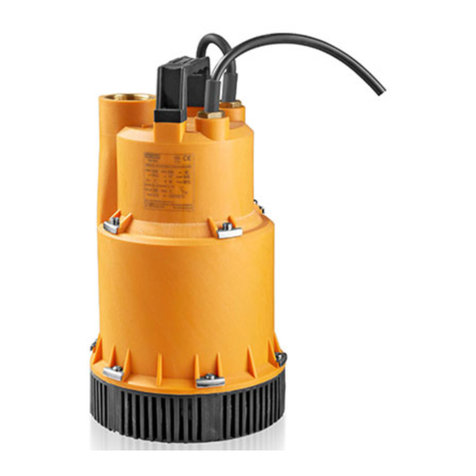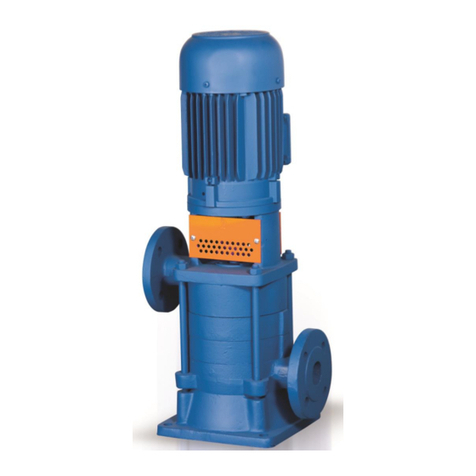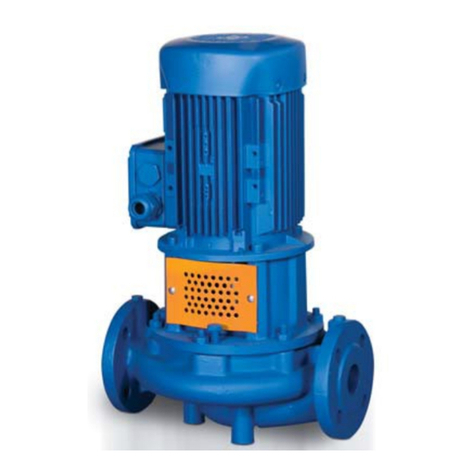
Mas Grup
1
TABLE OF CONTENTS Page No
Introduction 1
1.Important Safety Precautions 1
2.General 1
3.Safe Operating Conditions 2
4.Technical Information 3
5.Transport and Storage 3
6.Assembly/Installation 4
6.1.Location of Installation 4
6.2.Piping 4
6.3.Motor Connection 4
7.Commissioning, Start up and Operating 5
7.1.Preparations Before Start up 5
7.2.Checking The Direction of Rotation 5
7.3.Start up Procedure 5
7.4.Shut Down Procedure 5
8.Maintenance 6
8.1.The Checks During the Operation 6
8.2.Service 6
8.3.Spare Parts 6
9.Noise Level and Vibration 7
10. Disassembly, Repair and Reassembly 7
11. Information About Frequency Inverter 8
12. Possible Failures, Causes, Solutions 14
13. Pump Dimensions Table 15
14. Tightening Torques 22
15. Forces And Moments at The Pump Flanges 23
16. Sample Plumbing 24
17. INM/INL Sectional Drawing and Part List 25
18. INM Drawing for Dismantling 28
19. INM/INL Series MEI Value Tables 30
20. Figure List 31
21. Table List 31
INTRODUCTION
This manual contains instructions for the installation, operation and
maintenance of the INM/INL type non-self priming in-line centrifugal
pumps of MAS DAF MAKINA SANAYI A.Ş.
Please read carefully this manual and apply all the instructions to
operate pumps without problems. Pumps shall be used for their
intended duties. In this manual, there are information on operating
conditions, installation, starting-up, settings and main controls of
pumps.
These operating and maintenance instructions contain MAS DAF
MAKINA SANAYI A.Ş.`s suggestions. The special operating and
maintenance information of the plumbing that a pump is fitted to is not
considered in these instructions. This information must be given by the
plumbing constructors only.
Please refer to instructions of plumbing constructors.
Please pay attention to the warnings in this manual and ensure that it is
read before the installation-start up process. MAS DAF MAKINA
SANAYI A.Ş. is not responsible for the accidents resulting from
negligence.
If you cannot find an answer to your questions in this manual, it is
suggested that you contact MAS DAF MAKINA SANAYI A.Ş. Please
inform us about the rated value and especially the serial number of the
pump when you get in contact for help.
The safety instructions in this manual cover the current national
accident protection regulations. Beside all of these, an operation, work
and safety measure imposed by the costumer has to be applied.
The Signs Used in This Operation Manual
Read the instructions carefully in this operating manual
and keep it for your future reference.
Warning sign against the electrical risks
Sign for the operator’s safety.
1. IMPORTANT SAFETY PRECAUTIONS
In order to minimize the accidents during the mounting and putting into
service of the pump, the following rules have to be applied:
1. Do not work without taking safety measures relevant to equipment.
Cable, mask and safety band must be used when necessary.
2. Be sure there is adequate amount of oxygen and there is no toxic
gaseous around
3. Before using welding or any electrical equipment make sure that
there is no risk of explosion.
4. Check the cleanliness of the area to take care of your help. (Dust,
smoke, etc.)
5. Do keep in mind that there is a risk of having accidents related to
electricity
6. Do not lift the pump before you check the transport equipment.
7. Be sure you have a by-pass line
8. Use helmet, eye glasses and protective shoes for your safety
9. Place a protective barrier around the pump within the necessary
safety area
10. Dust, liquids and gaseous that may cause overheating, short circuit,
corrosion and fire must be kept away from the pump unit.
11. By checking the noise level of the pump unit, necessary measures to
avoid noisy operation of the pump that can have harmful effects on
the personnel and environment.
12. Be careful about the direction of transport and storage.
13. Cover appropriately the moving parts to avoid possible injury of the
personnel. Mount the coupling guard and belting before starting-up
the pump
14. All the electrical and electronic applications must be performed by
authorized person conforming EN60204-1 and /or domestic
instructions.
15. Protect the electrical equipment and motor against overloading
16. If flammable and explosive liquids are pumped, ground connection of
electricity should be carried out properly
17. Do not expose the pump unit to sudden temperature variations
18. All personnel who work with the waste water system need to be
vaccinated in case of contagious diseases.
19. If the pump contains hazardous liquids, one must use protective
helmet against the risk of splatter. One also must accumulate the
liquid in a proper container against any risk of leakage.
All Other Health and Safety Rules, Laws and
Regulations Must Be Applied
2. GENERAL
2.1.Definition of Pump and Usage Areas
INM/INL series pumps are non-self priming in-line centrifugal pumps.
They are used in
•Water networks and pressurization facilities
•Irrigation, sprinkling and drainage systems
•Filling-Draining of tanks and reservoirs
•Hot and cold water circulation in heating and cooling systems
•Condense water pumping
•Water circulations in pools
•Health and purification facilities
•Industrial and social facilities
•Fresh and sea water pumping in ships
They shall be used to pressurize liquids (up to 90°C) which are clean or
mildly impure, non abrasive, and not containing large solid particles or
fiber.
Please contact MAS DAF MAKINA SANAYI A.Ş. for liquids that have
different chemical and physical specifications.
INM/INL pumps comply with DIN 24255 standards within nominal
capacity range.
Sign for protecting against explosion.
































